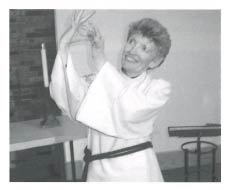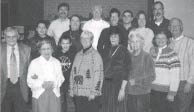As the time for the worship service approaches, church members gather in the sanctuary, animatedly sharing stories about sick children, new babies, workplace conflicts. Suddenly the sanctuary light flickers on and off. Rather than showing surprise, parishioners take their seats facing the altar. There is no prelude. Pastor Dorothy Sparks smiles broadly as she makes the parish announcements. But the voice I hear is not Pastor Dorothy’s. It’s the voice of a woman two rows in front of me; she is interpreting for those like me who can hear but who don’t understand American Sign Language. Here at Bread of Life Lutheran Church for the Deaf, an interpreter is provided for the hearing! Worship is led entirely in American Sign Language.
As part of my thesis research in the Religious Studies program at the University of Colorado in Boulder, I visited two Deaf churches where I attended worship and interviewed pastors and parishioners. My interest was at first academic, but what left the greatest impact on me didn’t come from theory or sociology or academic pondering. It came from worship.
A Language All Its Own
Most hearing people experience worship services mainly though their aural sense. We hear a sermon, we sing the hymns and liturgy. We worship primarily through speaking and singing and the playing of music. But to the Deaf, whose language is visual, worship is visual. Pastor Dorothy, the first Deaf pastor in the congregation’s eighty-year history, explains how worship at Bread of Life became what it is today:
I was a member here for years before the Bishop gave me special permission to serve as the pastor. During that time I wasn’t satisfied with the worship service. My spirit felt depressed. The worship didn’t reflect Deaf culture and Deaf values. . . . When I became pastor, the Bishop told me that we could change the liturgy to fit [the Deaf] so I slowly began to eliminate some of the songs. Lots of songs in church are boring for the Deaf. And we love PowerPoint!

As a Lutheran who prides myself on being liturgically conservative, I had to reevaluate my firm stance against discarding elements of the liturgy and bringing video screens into the sanctuary. I left my interview with Pastor Dorothy wondering, What is the role of culture in worship? At what point does holding on to traditions hinder our worship?
The great reformer Martin Luther insisted that worship and the Bible be in the language of the people. In our day and age this doesn’t seem all that revolutionary, but think about what it means for a people whose language is visual and not spoken. At Bread of Life, the implications of worshiping in the native language of the congregation reach far beyond preaching and offering prayers in American Sign Language. It must be noted here that ASL is a language in its own right, with a particular grammar and syntax, and not merely a manual representation of English.
Seeing the Proclamation of the Word
Using ASL was particularly powerful when watching rather than hearing the familiar words introducing the reading of Scripture. In hearing Lutheran churches the gospel reading is announced by the singing of the Alleluia, after which the pastor says, “The Gospel of our Lord is written in the [chapter and verse] of the [book],” to which the congregation responds, “Glory to you, O Lord.”
At Bread of Life, the Bible faces the congregation, opened to the gospel reading. As Pastor Dorothy stands aside the altar she places her hands in one fist over another on the open page of the Bible, then, as her hands come out from the Bible toward the congregation, her fingers flutter, opening up the Word of God to the congregation. The action is striking. The gospel is hardly able to be contained as it jumps out to meet the congregation.
Pastor Dorothy signs the gospel message and then she “puts it back” in the opposite way than she “took it out.” By her actions she has powerfully expressed the living nature of the gospel in a simple gesture. While the announcement of the gospel reading at Bread of Life isn’t liturgically traditional, it nevertheless complies with the tradition of the Lutheran church. It is in the language of the people.

Passing the Peace
Deaf folks love to chat. Hearing folks are submerged in the language: the majority of people we encounter speak it, it’s on the radio and TV, we read it in our books and newspapers. We can even pass other people in conversation and understand what is being said. Not so for most Deaf people. So when they are in a signing environment, they make the most of it—in fact they have the reputation for closing down bars and restaurants!
Now, I love the part of the service called Passing the Peace. I love how I feel renewed to come to the Table after offering a sign of peace to the believers around me. So I was disappointed when there was no passing the peace before communion at Bread of Life—only to laugh when I later realized that it had been moved to the very last part of the worship service. Why the change? Because Pastor Dorothy had been having a hard time getting around to starting Communion when the peace was in the middle of the service. Unorthodox? Perhaps, but fully appropriate for the linguistic and cultural needs of this congregation.
Other Lessons
I’m not a big fan of PowerPoint in worship. But at Bread of Life, the congregation loves PowerPoint. Pastor Dorothy explains, “We don’t have microphones to help amplify the sermon and prayers, so we use PowerPoint. For us it is a welcome visual amplification of what is being signed.” Another opinion to reconsider!
I often get dizzy when I close my eyes so I keep them open during prayer—it’s less distracting than falling over.
At Bread of Life, I fit right in. Not only do Deaf folks not close their eyes during the prayers of the people, they also spend about twice as much time on them as in most hearing churches. Once again, this adaptation is a reflection of the culture. Deaf culture highly values community ties. During the prayers of the people at Bread of Life, each name is finger-spelled up to God and a candle is lit for each person petitioned—a beautiful sight.
What’s to be gained by opening ourselves to the worship of other cultures and languages? Perhaps in the process we will see liturgy and worship through a whole new lens. This new view can help us sift through what is essential, what is optional, and what is sacrosanct in Christian worship. How are we as hearing Christians worshiping God through visual communication? Try taking a small part of your worship service that is traditionally spoken or sung and see what happens when you express this visually instead. Perhaps borrowing this technique from our Deaf brothers and sisters in Christ will renew our own worship!

